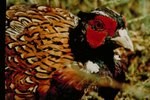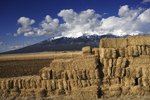Slaughterhouses are places where animals are slaughtered for food. Most slaughterhouses obtain permits to prepare only one sort of meat, though it isn't uncommon to see larger slaughterhouses with multiple wings for processing different types of meat. Slaughterhouses are heavily regulated and thoroughly inspected to ensure a safe supply of meat.
Hooved Livestock
Slaughterhouses for animals such as pigs, goats, cows, sheep and horses are usually large buildings, due to the size and number of animals that are being processed daily. These animals are usually led from their transportation, and metal cuffs are clamped around their hind legs. Chains raise them so their front legs dangle. They are mechanically pullied to a section of the slaughterhouse with a drain in the floor and then stunned, usually by a strong electrical jolt to the head. The animal's jugular vein is severed, and the animal is left to bleed out. Kosher slaughter is performed without using the Taser. In this case, the animal's throat is laid open by a sharp knife. Sometimes, the animal may be nearly beheaded to make death swifter. Usually, these larger animals are cut into chunks by machetes or chainsaws due to their bones being so thick. Some are sorted into packaged meats, such as steaks, ribs and roasts, while others are sent in chunks or whole carcasses to butchers to be cut inside their stores.
Poultry
Poultry slaughter of various types are nearly all the same. Birds are locked into small ankle cuffs that hang them upside down along a constantly moving conveyer line. Like hooved livestock, they are stunned. In larger slaughterhouses they are usually sent through a machine that slices open their throat. Ideally, the bird is dead before it is dumped in a scalding bath to remove the feathers in as quick a manner as possible. When the bird is removed from the bath, any remaining feathers are plucked, the head and feet are removed, a quick health inspection is done and it is packaged for sale.
Exotic
Exotic slaughterhouses cover rarely farmed animals, such as zebra, elk, deer, ostrich and other species. These animals are usually considered to be more costly, and therefore the meat will usually be more expensive. Their slaughter is generally performed in small numbers, in family-owned companies that make the death of the animal as quick and painless as possible due to the concern that the adrenaline may make the meat acquire a more "gamey" taste. These meats are also almost always kosher, due to the same risk with adrenaline. The meat is often sold straight from the farm or a neighborhood butcher. Few exotic farms ship their meat long distances due to cost.




